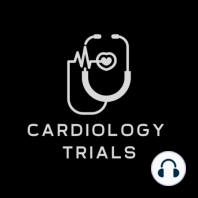10 min listen
Review of the ISIS-3 Trial
ratings:
Length:
9 minutes
Released:
Jan 18, 2024
Format:
Podcast episode
Description
Lancet 1992;339:753-770.Background Results from the GISSI and ISIS-2 trials demonstrated a clear benefit for the early opening of acutely blocked arteries with fibrinolytic treatment in patients presenting with STEMIs. ISIS-2 also demonstrated the benefit of aspirin in the acute and subacute phases of MI. However, after opening a blocked artery, concern for re-occlusion persisted, especially in the first several days to week, and experts postulated that antithrombotic therapy with heparin could improve outcomes compared to use of aspirin alone. The 3rd study from the ISIS group sought to test the hypothesis that therapeutic heparin plus aspirin reduced mortality compared to aspirin alone in patients treated with early fibrinolytic therapy. The investigators also sought to test whether different fibrinolytic regimens were safer and more effective compared to each other. *Since treatment with fibrinolytic therapy is no longer standard practice in most places and no significant differences in fibrinolytic regimens were ultimately reported, we will focus only on the heparin plus aspirin versus aspirin alone portion of the study.Patients Patients were eligible for ISIS 3 if they were thought to be within 24 hours of the onset of symptoms of suspected or definite acute MI (with or without ECG changes) and if they had no definite contraindications to fibrinolytic therapy. Contraindications were not specified by protocol but by the responsible physician; standard contraindications to fibrinolysis were suggested. Patients were eligible even if aspirin or heparin was thought to be clearly contraindicated or if it was thought that aspirin alone was not enough (i.e., that some anticoagulant was clearly indicated). In such cases, patients were still to be randomized and the allocated antithrombotic regimen was then modified as thought appropriate for the particular patient.Baseline characteristics The majority of patients were men (73%) and under the age of 70 years who presented within 6 hours from the onset of pain (78%). Enrolled patients appeared to be generally stable as only 6% had SBP <100 mmHg and only 15% had a heart rate ≥100 bpm. Patients with anterior and inferior STEMIs were evenly represented (35% and 34%), respectively and just under 2/3rds of patients presented within 6 hours from pain onset and had ST elevation on their presenting ECG.Procedures The study utilized a 3x2 factorial design. Randomization was done via a 24 hour direct line telephone service which took into account a limited set of baseline characteristics. All patients were randomly assigned to 1 of 3 fibrinolytic treatments as well as to either heparin plus aspirin or aspirin alone. All patients were to receive 162 mg of enteric-coated aspirin given daily for one month, starting immediately with the first tablet crushed or chewed for a rapid antiplatelet effect. Those assigned to heparin plus aspirin were to receive a fixed dose regimen of 12,500 IU of Calciparine (an injectable form of heparin), starting 4 hr after randomization and given subcutaneously twice daily for 7 days or until discharge. For patients assigned to aspirin alone, anticoagulation could still be used if the responsible physician felt it was clearly indicated with no rules governing this.At discharge, a single-sided form was to be returned to the trial office that provided further identifiers to assist central mortality follow-up after discharge, and brief details of the treatments that were given in hospital, of any apparent side-effects of treatment, and of major events in hospital. Available cause-of-death information was reviewed (blinded to treatment allocation) by the trial coordinator. Causes of death were defined as either “definitely non-vascular” or “vascular.”Endpoints The primary endpoint of the trial was intended to be vascular mortality within the first 5 weeks (35 days), but the investigators ended up reporting all-cause mortality since non-vascular mortality was rare and d
Released:
Jan 18, 2024
Format:
Podcast episode
Titles in the series (41)
Review of the GISSI-2 Trial by Cardiology Trials
